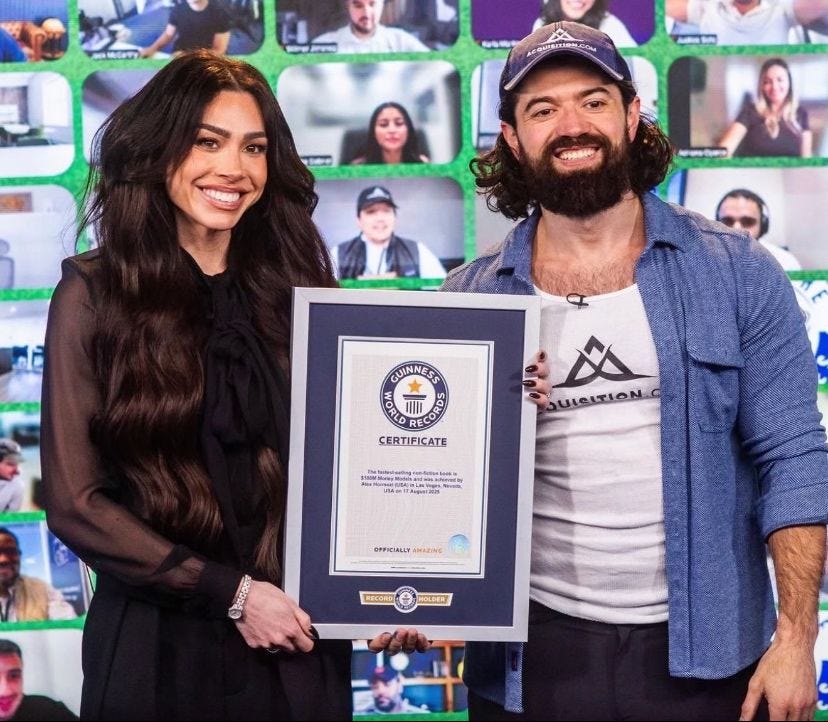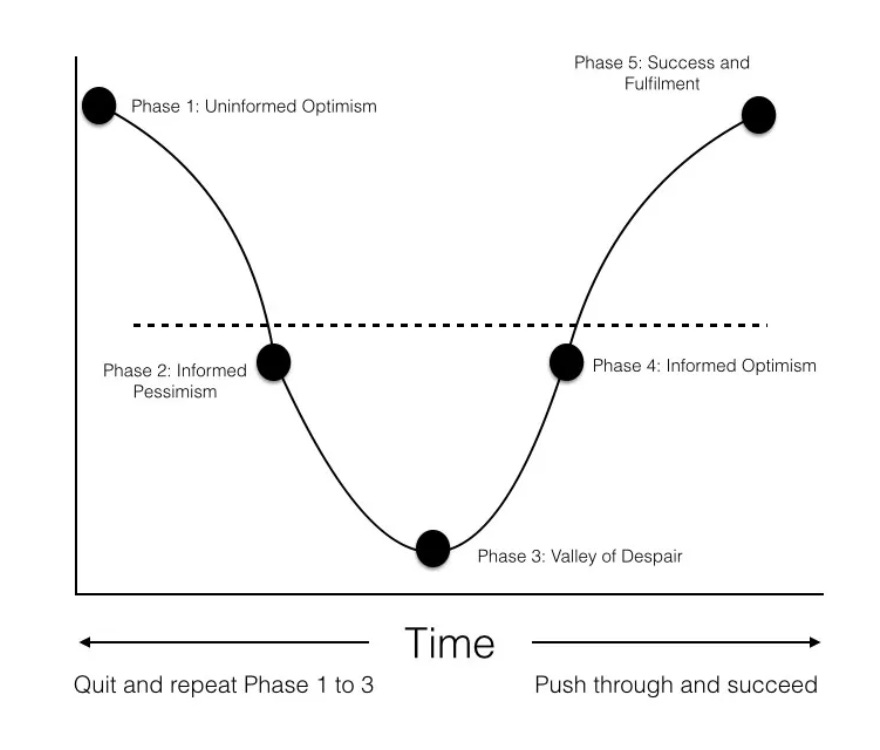The Lie of Overnight Success
Why courage, not shortcuts, is the real algorithm for growth
“The single greatest skill you can develop is the ability to stay in a great mood in the absence of things to be in a great mood about.” —
There are no quick fixes in life. And if someone’s selling you one, they’re selling you a lie.
We’re living in the era of shortcuts.
Buy this course.
Hire this coach.
Run this playbook.
And suddenly, you’ll be a millionaire… while sipping rosé on a beach in Tulum.
Sounds good, doesn’t it? Too good. Because it is.
Desperation doesn’t make you ambitious. It makes you gullible. And there’s an entire economy built to monetize the difference.
What You Don’t See
Sure, there’s luck. A video goes viral. The algorithm decides to bless you one Tuesday afternoon. But behind almost every “overnight success” you admire are years of invisible work.
Most influencers with millions of followers spent five to seven years posting into the void before they “blew up”. In the creator economy, now valued at $250 billion and projected to hit $528 billion by 2030 (inBeat Agency, 2025), only 4% of its 207 million creators earn over $100K a year (Goldman Sachs, 2023).
The average creator takes 6.5 months to earn their first dollar, 17 months to become self-supporting, and 24+ months to land a brand partnership (DemandSage, 2025). It’s not 18 months of hustle that builds empires; it’s compounding consistency over years for most who break through. The truth is less glamorous than the ad you saw in your feed.
The algorithm rewards the performance of success far more than success itself, and we’ve learned to mistake one for the other.
The Hormozi Example
Leila and
will be the first to tell you about the seasons of failure, the businesses that didn’t work, the sacrifices nobody clapped for, the relentless discipline it took to build what they have now.Most people didn’t know who they were until the past year or two. Then, on August 17, 2025, Alex broke the Guinness World Record for the biggest non-fiction book launch in history, selling 2.9M+ copies in 24hrs over a livestream (Guinness World Records, 2025).
But what looked like an “overnight success” was actually a decade in the making, years of building in public, giving away free value, staying consistent when nobody was watching. They’ve built a brand rooted in trust and proof, not perfection.

Alex went broke at 26, his first few gyms tanked, and his business partner straight-up stole all the profits, leaving him $100K in credit card debt and sleeping in motels. He even confessed to Leila early on: “I’m a sinking ship” (Medium, 2023).
Leila was arrested six times in her early hustles (mostly petty stuff from scraping by), quit her job at 23 to co-found Gym Launch with a broke business partner. She convinced a skeptical Alex to go all-in despite the red ink (Lewis Howes, 2025).
Your darkest chapter might just be the prologue everyone skips when they try to copy your success story.
Together, they scaled it to $100M+ across industries, but only after two years of scraping by on less than $1,000, maxing out cards, and turning their first big win, $500K in a single month, into fuel for the long haul (Medium, 2023). They refused to quit when it didn’t look like it was working.
No hacks. No shortcuts. Just courage and relentless follow-through.
The Valley of Despair: Where Dreams Go to Die
The “Valley of Despair” is a concept borrowed from psychology, rooted in Elisabeth Kübler-Ross’ five stages of grief and later adapted by change management expert John Fisher for organizational change, describing that brutal dip where morale crashes and doubt screams loudest (Fisher, 1997; Kübler-Ross, 1969).
Alex Hormozi popularized it for entrepreneurs, framing it as the make-or-break stage in his 5-phase model of any opportunity: the point where most bail, but the 1% who push through turn despair into dominance (Hormozi, 2024).
Stage 1: Uninformed Optimism — You start something new, high on possibility, convinced this is finally it.
Stage 2: Informed Pessimism — Reality hits. You realize it’s harder than the Instagram reel made it look.
Stage 3: The Valley of Despair — Effort and results feel so misaligned that quitting seems logical. Most people tap out here. Six months in, still broke, still invisible, wondering if they’re delusional.
Stage 4: Informed Optimism — The fog lifts. You’re not “made” yet, but you see the path. You understand the game.
Stage 5: Success and Fulfillment — The compounding catches up, and the world calls it “overnight.”
The Valley of Despair is the toll bridge between wanting it and becoming it. And it takes courage to go through it.
Why It Takes Courage
Because lasting success doesn’t come from hacks, it comes from courage.
Resilience, the ability to adapt and bounce back from setbacks, is the #1 predictor of long-term success (The New Yorker, 2016; Springer, 2021). Studies show resilient people score 96% higher on perseverance metrics than their peers, turning failures into fuel rather than roadblocks (The Resilience Center).
But resilience isn’t a trait you’re born with; it’s forged through courage: the deliberate choice to face fear, fail publicly, and keep showing up (PositivePsychology, 2025). Without that spark of courage, resilience crumbles. With it? You build the grit that outlasts every algorithm or trend.
Resilience is what you build after courage breaks you the first time. Courage is the spark that keeps you in the game when logic says to quit.
Logic will always tell you to quit because it’s working with incomplete data. It doesn’t know what month you break through. Courage is the arrogance to believe you’re one decision away from proving logic wrong. And sometimes, arrogance is just belief that hasn’t been validated yet.
Courage is not an ad you can buy. It’s not a funnel you can plug in, a hack or a weekend course. It’s the quiet, daily act of choosing to stay in motion. It’s showing up, over and over, until what you’re building actually matters.
And that takes time. You can’t skip that time.
The Long Game
Nothing real is built overnight.
Not a business.
Not a brand.
Not a body of work.
If you’re frustrated because the payoff hasn’t come yet, remember this: consistency compounds.
The days nobody notices are the deposits that make the breakthroughs possible. I tell myself the same thing every time I post a new reel on Instagram or publish a Substack. In a space where 96% of creators never hit six figures, those quiet deposits are your edge (Social Media Today, 2024).
In a world optimizing for attention, obscurity is where the real work gets done.
Your Next Step
Don’t chase the quick fix.
Take the next courageous step.
Publish the post. Make the call. Ship the draft. Stick to the routine. Not because it guarantees instant success, but because it builds the kind of resilience that actually lasts.
Because when the hacks fade, courage is what remains.
The people selling you shortcuts have already taken the long road. They’re just betting you won’t notice. Don’t buy the highlight reel. Build the behind-the-scenes that makes your own highlight reel inevitable.
With Courage,
Maryam
Sources:
Guinness World Records, 2025 - “Fastest-selling non-fiction book”
inBeat Agency, 2025 - “75 Creator Economy Statistics Every Marketer Needs in 2025”.
Goldman Sachs, 2023 - “The Creator Economy Could Approach Half-a-Trillion Dollars by 2027”.
Social Media Today, 2024 - “New Report Shows That 96% Of Online Creators Make Less Than $100K per Year”.
DemandSage, 2025 - “32+ Creator Economy Statistics of 2025 (Market Size Data)”.
Medium, 2023 - “The Full Story of Alex Hormozi: From Broke at 26 to Worth $100,000,000 at 32” by Oscar Lagrosen.
Lewis Howes, 2025 - “How CEO Leila Hormozi Went From Broke, Anxious & Arrested 6 Times To $100M Net Worth”.
Hormozi, 2024 - “The 5 Stages of Any Opportunity”
The New Yorker, 2016 - “How People Learn to Become Resilient” by Maria Konnikova.
Springer, 2021 - “When Problems Just Bounce Back: About the Relation Between Resilience and Academic Success in German Tertiary Education”.
The Resilience Center, undated - “Resilient People Are More Likely to Achieve Success”.
PositivePsychology, 2025 - “How to Measure Resilience With These 8 Scales”.
Fisher, 1997 - “Personal Transition and Change” (John Fisher’s Transition Curve model).
Kübler-Ross, 1969 - “On Death and Dying”.





"Take the courageous step" - reminds me of when a friend told me once.... "Don't take thing about, just do it..." - ties into exactly what you're saying :)
Great post!
I still have a few years left for my overnight success to kick in. 😆